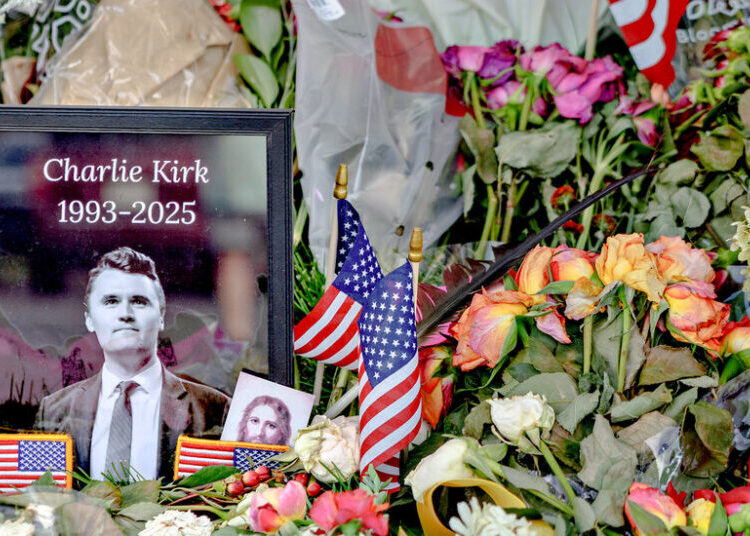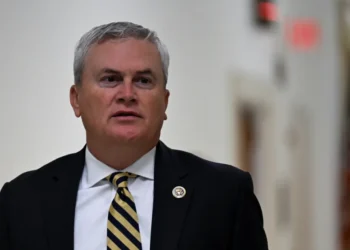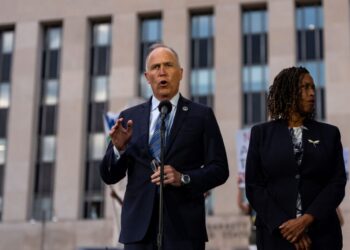NEW YORK — Megan Sewell is caught in a dilemma. Without a job, she can’t afford day care. But without day care, she can’t find a job.
“Bring the kid to the interview? That’s not reality,” Sewell said during an outing to a Brooklyn playground as her three children chased each other through the fallen leaves. Her partner supports the family working for a garbage company. But if she could use her training as a dental assistant, Sewell imagines the ways they could do better for their kids — renting a car once in a while for a day trip out of the city, saving for a house.
Instead, she stays home with the 1-year-old, her youngest. “I’m tired of being home. I feel like I do not exist. I’m just stagnant and having babies.”
Child care is an affordability morass for legions of Americans: The cost for a family with two children now outpaces the average rent in all 50 states, according to an analysis from the child advocacy nonprofit Zero to Three. And a year’s worth of care costs more than in-state college tuition in 39 states, the data show, meaning a family could have paid for a bachelor’s degree by the time their firstborn started kindergarten.
The cost issue helped propel the victory of Zohran Mamdani, who made universal child care a cornerstone of his groundbreaking mayoral campaign. It’s also why dozens of states and cities proffer their own versions of free preschool.
Some state and local governments — including in D.C., Boston and San Antonio — have come closest to fulfilling this promise, especially for 3- and 4-year-olds. Others, like some in Oregon and Florida, are attempting the feat but facing frustrated constituents. This mixed record shows how hard it will be for Mamdani and other politicians to deliver on their pledges, and why it matters to so many Americans.
There is growing consensus among Republicans and Democrats that government should play a greater role in lowering the cost of child care. Some advocates call for greater subsidies, arguing that parents benefit from the cost savings and the ability to work, and that providing high-quality education at the youngest ages boosts brain development and pays dividends for society in the long run. Others are concerned about the cost, and sometimes prefer programs that do not encourage mothers of young children to work outside the home.
In the absence of national policy, states and cities have taken on child care, leading to a patchwork of policies across 45 states and numerous local jurisdictions. What they offer, what they spend and how they pay for it varies widely.
Availability
Forty-five states now offer publicly funded preschool to a portion of their 4-year-olds, and some programs start as young as 3. Publicly funded child care for 2-year-olds and younger is rare, though Mamdani’s plan would be open to infants as young as 6 weeks old.
New Mexico recently made headlines by promising day care subsidies for every child in the state, saving families $13,000 a year on average. The District has been paying for day care for an increasing number of children from low-income families. This year, nearly 6,800 toddlers received subsidies; qualifying families earned no more than three times the poverty level ($61,320 for a single parent with one child).
Though many states refer to such offerings for 4-year-olds as “universal preschool,” the reach of such programs varies. Only the District, where 95 percent of 4-year-olds attend, approaches the coverage level of a public elementary school. The state with the highest enrollment is Vermont, at 82 percent, but the preschool program is only required to operate two hours a day.
Even in states with substantial programs, “universal” doesn’t always mean available for all the families who want it. Utah’s program, for example, serves only 2,000 children across 41 percent of the state’s school districts. In Maine, nearly half of 4-year-olds are in public programs, putting the state just above the national average. But 12 percent of the state’s school districts don’t participate.
Funding
As a rising number of Americans tell pollstersthat cost is a top reason they are choosing not to have more children, policymakers are increasingly debating how government spending can support families. When it comes to state-funded preschool, the gap between availability and demand generally comes down to money and space.
States and cities fund preschool in a variety of ways. Philadelphia raises $68 million a year through a controversial soda tax. Voters have approved a sales tax in Denver and San Antonio, and a property tax in Cincinnati, Austin and New Orleans.
The amount that states spend per child ranges widely, according to the National Institute for Early Education Research, from $2,856 a year in Florida to $18,637 in Oregon. The District spends $23,785, which is on par with spending on elementary school students. The city is one of several that has also directly spent money to increase the wages of child care workers.
Mamdani’s plan would cost $6 billion to fully cover all children starting at 6 weeks old for those who want it. The mayor-elect is searching for ways to fund it, including discussing a tax on high earners, with New York Gov. Kathy Hochul (D).
The quality of child care is hard to quantify, but experts say facilities with smaller groups and teacher-to-child ratios tend to have better educational outcomes. That adds to the cost, as does hiring staff who have more training or postsecondary degrees.
Even with public funding, communities also need space for the preschools and workers to staff them, both of which can be in short supply. Child care tends to be heavily regulated, and facilities that meet detailed state rules on everything from bathrooms to outdoor space can be hard to find.
Most states and cities use what is called a “mixed delivery” model, in which some 4-year-olds go to pre-K programs at elementary schools and others go to private child care facilities where the state pays for their care.
Multnomah County, Oregon — home to the left-leaning city of Portland — has become something of an exemplar, and a cautionary tale, for child care advocates. The county passed a ballot initiative in 2020 to tax high-income residents — those earning more than $125,000 a year — to pay for a full-day preschool program that would be one of the nation’s most extensive.
Today, only about half of Preschool for All applicants get a spot, though the county promises to accommodate all 3- and 4-year-olds by 2030, or upward of 11,000 children. Some private child care centers have refused to participate, hesitant to agree to the county’s rules for preschools.
Parents who are paying for the region’s costly child care, which runs close to $16,000 a year for a preschooler and more for a younger child, are growing frustrated. Message boards bristle with complaints.
Gov. Tina Kotek (D) and the state legislature have both tried unsuccessfully to repeal the tax that funds the program, saying they fear it will drive wealthy residents out of the state.
Laura Labarre, who worked in the child care industry and is now a parent herself, is paying for private preschool in Portland because there isn’t a free spot for her family. She wants her city to serve as a lesson for other leaders who want to expand preschool in their communities.
“Even though the money is there, it cannot be spent fast enough to create slots to actually serve all preschoolers,” she said, noting how hard it is to open up child care centers. “The money isn’t to establish facilities. It’s to run them, if they exist.”
Time
The programs are not meant as full-time babysitters, and when kids go to publicly funded preschool, what they are getting ranges widely. In some states, kids are guaranteed as few as two hours of care per day — not enough for a parent to work without cobbling together additional coverage. Other programs align with elementary school hours, about six to seven hours a day.
A decade ago, then-Mayor Bill DeBlasio (D) led a massive campaign to offer preschool to New York City’s 3- and 4-year-olds. It serves more than 100,000 children in the five boroughs.
Sewell has her 3-year-old enrolled in a city-supported preschool, while her 8-year-old is in grade school. But the baby is still two years away from qualifying for care under the guidelines.
When Roxanne Medina, 37, picked up her youngest, Allahsay, 3, from a city-funded preschool in Brooklyn last week, she considered what it meant. Had she had access to free child care earlier, the mother of five says she doesn’t think her family would have spent the past 18 months in a homeless shelter. Before Allahsay was old enough for free preschool, Medina spent most of her time taking care of him.
“I probably would have been looking for an apartment and been in one already,” she said. She believes class time and interacting with other children would have benefited her son, too.
“It would be good for them. Maybe they can learn more and be more independent in school.”
Khadijah Carmichael’s sons joined Medina’s kids on the playground across from Allahsay’s preschool. Carmichael has a cosmetology license but hasn’t been able to work much with three sons at home. She is expecting a fourth in December.
If Mamdani’s plan for day care subsidies comes to be, Carmichael said that she could go back to work and help her partner, who works in fast food, support their family. It would take some of the pressure, a lot of the weight off,” she said. “It would be a lot better, having a day care.”
The post What the best free preschool programs reveal about child care in America appeared first on Washington Post.




